Intel Core Duo: AOpen i975Xa-YDG to the Rescue
by Gary Key on May 4, 2006 8:00 AM EST- Posted in
- Motherboards
Video Encoding Performance
A traditional weak spot of the current Intel mobile processor offerings has been in the media encoding area when compared to AMD. Considering the main optimizations for the Core Duo centered on media encoding performance, we were very interested in seeing how this platform compared to current AMD lineups. We are utilizing an updated video encoding test suite for this article that includes AnyDVD, Nero Recode 2, Videora, Windows Media Encoder 9, and DivX 6.2.1. One video application missing is QuickTime PRO 7; we utilized it extensively on both test platforms but we ran into issues transcoding our sample video files during the overclocking testing. This is an issue we are currently addressing and hopefully we will be able to post results shortly.Our first test is quite easy - we take our original The Sum of All Fears DVD and use AnyDVD Ripper to copy the full DVD to the hard drive without compression, thus providing an almost exact duplicate of the DVD. We then fired up Nero Recode 2, selected our Sum of All Fears copy on the hard drive, and performed a shrink operation to allow the entire movie along with extras to fit on a single 4.5GB DVD disc. We left all options on their defaults except we checked off the advanced analysis option. The scores reported include the full encoding process and are represented in minutes, with lower numbers indicating better performance.
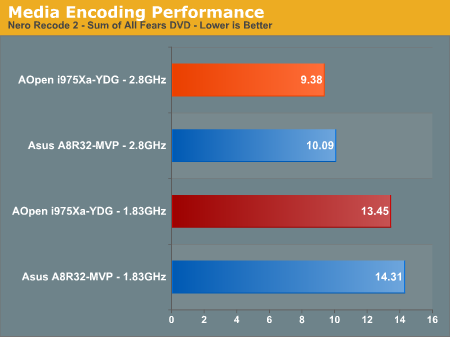
The results are very interesting as we did not expect the Intel system to perform this well. We were so surprised that we ran the test several times and verified our settings before accepting the test results. We guess the last few years of NetBurst results have tainted our cognitive abilities.
Our next test has us extracting Chapter 9 of our movie which will be used extensively in the rest of our benchmarks. After extraction we utilize AutoGK version 2.27 and DivX 6.2.1 to convert our .VOB file into a more accessible .AVI file. We utilize our standard settings and then let this program combination do its magic. We are reporting the numbers in two charts with frames per second and the time in minutes/seconds to complete the conversion.
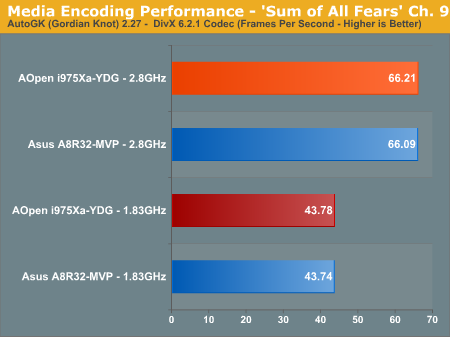
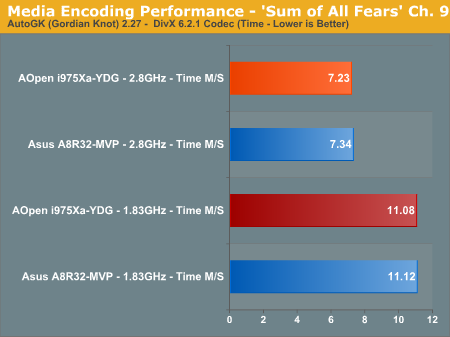
Unlike our Nero Recode 2 test results, this exercise has both systems performing equally. It either means this software is not optimized for a particular platform or the process is equally demanding on both systems.
Next on the list is the Windows Media Encoder 9 test that will convert our newly created .AVI file into a plasma screen pleasing WMV-HD format. We ensured our quality settings were set to High Definition. The values reported are in minutes/seconds for the conversion time, with lower numbers being better.
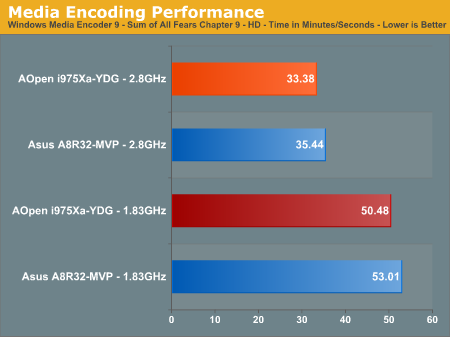
Once again, the Core Duo and the Opteron are close in the benchmark scores with the Intel platform performing up to 6% better in this benchmark. While both platforms are extremely competitive in this benchmark, the AOpen board clearly has the advantage in our scores.
Our final video tests utilize the Videora Converter products to perform a conversion of our Sum of All Fears Chapter 9 .VOB into the proper video format that our Xbox360, iPod, and Sony Playstation Portable can understand. We utilized the default settings for each program and have reported the results in minutes/seconds with the lower numbers being better. The final results show the transcoding process times for converting our standard 327MB file into a 43.2MB file for iPod, 111MB file for Xbox 360, and a 66MB file for PSP.
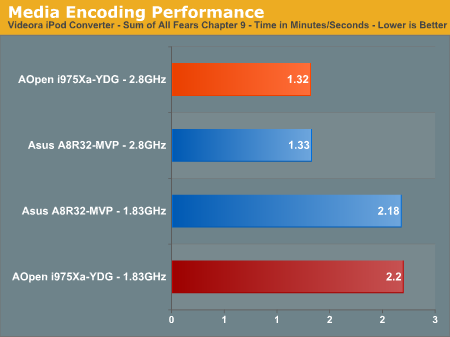
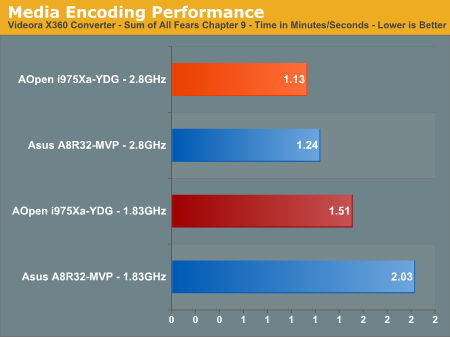
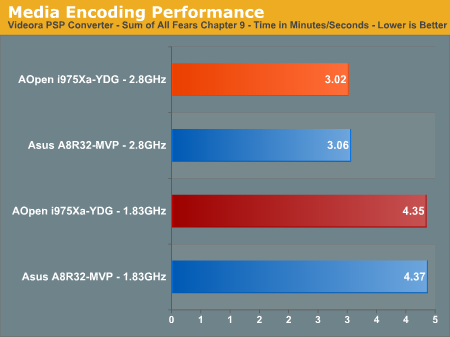
In these particular benchmarks both platforms are basically even with a minimal advantage going to the Intel platform in the more demanding Xbox 360 conversion. These results continue the pattern of the Intel Core Duo platform not being at a distinct disadvantage when compared to the current AMD offerings and actually having an advantage in most instances. Intel users can begin to rejoice now - just no dancing in the streets until the next product release please.










81 Comments
View All Comments
Viditor - Thursday, May 4, 2006 - link
Premiere Pro 2.0 has a 64 bit version that works very well. It has not yet been "optimized" for 64 bit (meaning that basic functions won't run much faster), but you have access to 4 GB+ of memory (which can be a HUGE help when dealing with very large movie and audio files).http://www.adobe.com/products/premiere/pdfs/premie...">Adobe Premiere Pro 2.0 pdf
Griswold - Thursday, May 4, 2006 - link
This was obviously a test of a mobile CPU on a desktop platform, so his point is valid. And what does SFF have to do with it?Calin - Thursday, May 4, 2006 - link
That more than 50% overclock is mind boggling - I hope this will bode well for the soon-to-be released Intel processors. Performance as good as or better than Opteron 175? Looks like Intel already have this side of the market covered.xsilver - Thursday, May 4, 2006 - link
have intel chipset limitations been discussed on the upcoming conroe?wont all conroes be runnning 1066fsb already? meaning there is little headroom left for fsb overclocking unless some serious progress is made on the new chipsets?
(300ish fsb is the current general limit for intel chipsets right?)
Gary Key - Thursday, May 4, 2006 - link
We felt guilty when raising the voltage up to 1.3875 as temps increased from 25c to 31c, makes you wonder what a really good heatsink/fan will on this board. :) Anyway, I think we reached the limit of our board around 267fsb in further testing with a water cooling unit. I am sure the CPU had more in it as temps were around 26c at load, or maybe not. We spoke with AOpen and it appears the boards will top out around 275FSB at this time, we had an early board and based upon some user experiences the retail boards are doing around 275 at this time. We have a retail board on the way for our HTPC article.
Griswold - Thursday, May 4, 2006 - link
What was the ambient (room) temperature?Gary Key - Thursday, May 4, 2006 - link
It varies during the day, variation is 20c~22c. There is a new program out that will measure the Yonah core temperature through the on-chip diode instead of the AOpen thermal sensor. I withheld our temperature and power consumption numbers until we decide which temperature reading to report as another utility in XP gives a slightly different reading also. Power consumption is excellent.
Our test system (11x255, ~2.8GHz)-
X1900XT
idle - 114w
load - 232w
X1900 CrossFire (P4 of video cards)
idle - 139w
load - 357w
redbone75 - Thursday, May 4, 2006 - link
That price is a bit daunting for a mobo. This is where if you absolutely have to build a PC right now I would go with an AMD system b/c you still get stellar performance at a lower price point. The A8R32-MVP is a little under $200, and the Opty 165 still costs less than the Core Duo T2400. So, although this is a great effort from Aopen, I personally would build the AMD system or just wait for Conroe/Merom to launch. Boy, but does this make your mouth water if you choose the latter, doesn't it?dexvx - Sunday, May 7, 2006 - link
Lol, what happened to the fanboi arguement of saving power for the long term (if you visit the AT forms, its frequently used arguement for not buying a cheap Pentium-D system)? Based on the powerdraw tests from Tech-report.com, you save more power going from a X2 to Yonah than from Pentium-D to X2.That Aside, this Aopen board *is* Meron compatible with a bios update. The folks over at xtremesystems.org has confirmed it.
Schmeh - Thursday, May 4, 2006 - link
I absolutely agree. I have been putting of upgrading my system for almost a year and I am glad that I did. I can't wait to see what Conroe and Merom have to offer. My only fear is that Intel will overprice them at launch.